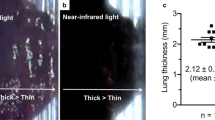Abstract
Background: Understanding the spatial and temporal drainage patterns of the pleural space could have profound impact on the treatment of lung cancer and mesothelioma. The purpose of this study was to identify the in vivo pattern of drainage from the pleural space to prognostic lymph node stations.
Methods: Fifty-six rats underwent pleural space injection of a novel lymph tracer composed of recombinant human serum albumin (HSA) covalently conjugated to the near-infrared (NIR) fluorophore IRDye78 via an amide bond (HSA-78). Nodal uptake was imaged at 10, 20, 30, and 60 minutes and 4, 12, and 24 hours after injection with a custom system that simultaneously acquires color video, NIR fluorescence of HSA-78, and a merged picture of the two. Six pigs underwent the same procedure with imaging at 30 minutes, 1 hour, and 24 hours.
Results: In both the rat model and the pig model, HSA-78 drained from the pleural space to superior mediastinal lymph nodes first, followed by other intrathoracic and then extrathoracic lymph nodes over the course of 24 hours.
Conclusion: NIR fluorescence imaging in two species shows that the superior mediastinal lymph nodes are the first to drain the pleural space. Over the course of 24 hours, the pleural space also communicates with other intrathoracic and then extrathoracic lymph nodes. This study also demonstrates an intraoperative method for identifying nodes communicating with the pleural space, with potential utility in the staging and/or resection of lung cancer and mesothelioma.
Similar content being viewed by others
REFERENCES
Sugarbaker DJ, Garcia JP, Richards WG, et al. Extrapleural pneumonectomy in the multimodality therapy of malignant pleural mesothelioma. Results in 120 consecutive patients. Ann Surg 1996; 224(3):288–96.
Sugarbaker DJ, Strauss GM, Lynch TJ, et al. Node status has prognostic significance in the multimodality therapy of diffuse, malignant mesothelioma. J Clin Oncol 1993; 11:1172–8.
Mountain CF, Dresler CM. Regional Lymph Node Classification for Lung Cancer Staging. Chest 1997; 111:1718–23.
Kang J, Kim KD, Chung KY. Prognostic value of visceral pleura invasion in non-small cell lung cancer. Eur J Cardiothorac Surg 2003; 23:S65–9.
Manac’h D, Riquet M, Medioni J, Le Pimpec-Barthes F, Dujon A, Danel C. Visceral pleura invasion by non-small cell lung cancer: an underrated bad prognostic factor. Ann Thorac Surg 2001; 71(4):1088–93.
Albertine KH, Wiener-Kronish JP, Roos PJ, Staub NC. Structure, blood supply, and lymphatic vessels of the sheep’s visceral pleura. Am J Anat 1982; 165(3):277–94.
Okiemy G, Foucault C, Avisse C, Hidden G, Riquet M. Lymphatic drainage of the diaphragmatic pleura to the peritracheobronchial lymph nodes. Surg Radiol Anat 2003; 25(1):32–5.
Pereira A, Grande N. Particle clearance from the canine pleural space into thoracic lymph nodes: an experimental study. Lymphology 1992; 25(3):120–8.
De Grand AM, Frangioni JV. An operational near-infrared fluorescence imaging system prototype for large animal surgery. Technol Cancer Res Treat 2003; 2(6):553–62.
Kim S, Lim YT, Soltesz EG, De Grand AM, et al. Near-infrared fluorescent type II quantum dots for sentinel lymph node mapping. Nat Biotechnol 2004; 22(1):93–7.
Zaheer A, Lenkinski RE, Mahmood A, Jones AG, Cantley LC, Frangioni JV. In vivo near-infrared fluorescence imaging of osteoblastic activity. Nat Biotechnol 2001; 19(12):1148–54.
Shao XJ, Ohtani O, Saitoh M, Ohtani Y. Development of diaphragmatic lymphatics: the process of their direct connection to the peritoneal cavity. Arch Histol Cytol 1998; 61(2):137–49.
Sugarbaker DJ, Norberto JJ. Multimodality management of malignant pleural mesothelioma. Chest 1998; 113 (1 Suppl):61S–65S.
Sugarbaker DJ, Flores RM, Jaklitsch MT, et al. Resection margins, extrapleural nodal status, and cell type determine postoperative long-term survival in trimodality therapy of malignant pleural mesothelioma: results in 183 patients. J Thorac Cardiovasc Surg 1999; 117(1):54–65.
Uren RF, Hoefnagel CA. Textbook of Melanoma. Thompson JF, Morton DM, Kroon BBR, eds. London: Martin Dunitz, 2003.
Author information
Authors and Affiliations
Corresponding author
Rights and permissions
About this article
Cite this article
Parungo, C.P., Ohnishi, S., De Grand, A.M. et al. In Vivo Optical Imaging of Pleural Space Drainage to Lymph Nodes of Prognostic Significance. Ann Surg Oncol 11, 1085–1092 (2004). https://doi.org/10.1245/ASO.2004.03.054
Received:
Accepted:
Issue Date:
DOI: https://doi.org/10.1245/ASO.2004.03.054




